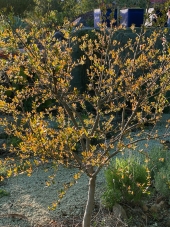
 2
2




I am creating the ultimate educational platform to make permaculture accessible to everyone.
To help, please answer a couple of questions (anonymously) at: https://nisandeh.com/permies-demographics-questionnaire/
 1
1




Building regenerative Christian villages @
https://jesusvillage.org/
 4
4








T Simpson wrote:I would start thinking about man made microclimates, bury geothermal heating, replace wire fencing with stone walls to reflect heat, add shade cloth, irrigation etc. whatever your needs.
For something more natural start thinking about wind currents on your property and how on a macro scale they bring rain clouds, cool air, warm air etc. and think about how you can direct it, trap condensation and look at your neighbors, there will only be so much you can do if neighboring land is desolate and provides no protection.
I am creating the ultimate educational platform to make permaculture accessible to everyone.
To help, please answer a couple of questions (anonymously) at: https://nisandeh.com/permies-demographics-questionnaire/




D Tucholske wrote:Diversity in native plant life is all I've got. You get enough of the local plants that would be in that environment together in one place, they make each other healthier & stronger, therefore more resilient.
I am creating the ultimate educational platform to make permaculture accessible to everyone.
To help, please answer a couple of questions (anonymously) at: https://nisandeh.com/permies-demographics-questionnaire/
 3
3




N. Neta wrote:
Could you please elaborate on “bury geothermal heating” or direct me to appropriate resources.
I’d also love to understand more about what you call “trap condensation”.
Building regenerative Christian villages @
https://jesusvillage.org/
 1
1




T Simpson wrote:Geothermal is storing the earth's heat, the heat can be stored or captured in underground pipes depending on your setup and how you want to use the heat. A root cellar is kind of the reverse effect.
There is also cable that is made to be put on roofs to melt snow when the temperature drops to a certain level, I have heard of people who bury this in their garden beds and turn them on in the winter. This uses electricity.
You could also place full water barrels or composters along the side of a greenhouse to act as a thermal mass that heats up and stores solar energy that can be piped under the greenhouse at night.
To trap condensation having a large tree canopy will do this naturally to some extent but you could also build structures that can catch water when there is little rainfall such as fog nets:
I am creating the ultimate educational platform to make permaculture accessible to everyone.
To help, please answer a couple of questions (anonymously) at: https://nisandeh.com/permies-demographics-questionnaire/





